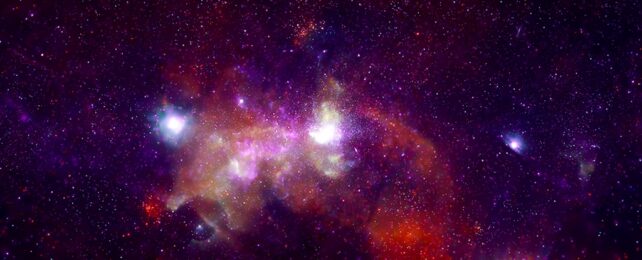Seen through a giant's eyes, our Universe's galaxies cling like foam to the surface of an eternal ocean, drawing into clumps and strings around inky voids.
This sparkling web has taken eons to come together, congealing gradually under gravity's guidance out of what was, billions of years ago, an evenly-spread fog of white-hot particles fresh out of the Big Bang's oven.
Slow as this growth seems to us mere mortals, University of Michigan physicists Nhat-Minh Nguyen, Dragan Huterer, and Yuewei Wen want to slow it down even further, fixing one of science's most vexing problems in the process.
Their suggested tweak to the model that currently best describes our Universe could resolve a significant conflict in observations of space's expanding waistline.
Complain as you might that you can't get something for nothing these days, there's more empty space up there today than there was yesterday. Something is causing nothingness to grow, squeezing its way into the gaps between galaxies to gently push the large scale structure of the Universe apart at an ever increasing rate.
Since we don't know what is behind this mysterious shoving, we refer to it as dark energy.
"If gravity acts like an amplifier enhancing matter perturbations to grow into large-scale structure, then dark energy acts like an attenuator damping these perturbations and slowing the growth of structure," says Nguyen, the lead author of an investigation into the large-scale structure's growth.
"By examining how cosmic structure has been clustering and growing, we can try to understand the nature of gravity and dark energy."
The precise rate of expansion, known as the Hubble constant (H0), isn't at all clear. Measure the way certain kinds of exploding stars retreat into the distance, you might get an acceleration of 74 kilometers per second per megparsec. Using the 'light echo' of stretched radiation still bouncing about after the Big Bang – the cosmic microwave background (CMB) – H0 is closer to around 67 kilometers per second.
That might not seem like much of a difference, but the discrepancy has persisted through enough investigations that it can no longer be dismissed as some trivial error.
Nguyen, Huterer, and Wen took a fresh look at the flat ΛCDM concordance cosmology model as a potential source of mistaken assumptions. If cosmology was a game of chess, this would be the board and pieces as laid out on general relativity's tiles, moved by dark energy's push, and aligned by dark matter's gravitational influences.
Rewinding the chess pieces we see today, we can effectively see how the game began, from a momentary blink of rapid inflation to a time where the first stars collapse, to the formation of galaxies and their eventual emergence into gargantuan, interconnected threads.
If for some reason this process deviated from what's predicted by the concordance model, impeding the growth of the Universe's large-scale structure, the tension between the different measures of the Universe's accelerating expansion would vanish.
The researchers used a combination of measurements involving ripples in the cosmic web, gravitational lensing events, and details in the cosmic microwave background to come to a statistically convincing conclusion that the cosmic web is growing slower than the flat ΛCDM concordance cosmology model predicts.
"The difference in these growth rates that we have potentially discovered becomes more prominent as we approach the present day," says Nguyen.
"These different probes individually and collectively indicate a growth suppression. Either we are missing some systematic errors in each of these probes, or we are missing some new, late-time physics in our standard model."
While there are no obvious contenders for what might put the brakes on the growth of the cosmic web, future measurements of the Universe's large scale structure might at least hint at whether there's a need to explore the idea further.
The Universe has taken 13.7 billion years to look this good. We can stand to wait a few more years to work out the secrets to such fine looking cosmological wrinkles.
This research was published in Physical Review Letters.
